Assessment of Future Water Demand and Supply under IPCC Climate Change and Socio-Economic Scenarios, Using a Combination of Models in Ourika Watershed, High Atlas, Morocco
Abstract
1. Introduction
2. Materials and Methods
2.1. Study Area
2.2. Data Collection
2.3. Climate Change
2.4. Hydrological Model
2.5. Calibration and Validation of WEAP
2.6. Demand Sites and Supply Sources
2.7. Scenarios Development
3. Results
3.1. Climate Change Projection
3.1.1. Downscaling Performance
3.1.2. Precipitation Projections
3.1.3. Temperature Projection
3.2. WEAP Calibration and Validation
3.3. References Scenario (RS) and High Population Growth Scenario (HPG)
3.4. Climate Change Scenario (CC)
3.5. New Irrigation Technique Scenario (NIT)
3.6. Improvement of Living Conditions (ILC)
3.7. Combination of the Two Adaptation Strategies (NIT + ILC)
4. Conclusions
Author Contributions
Funding
Acknowledgments
Conflicts of Interest
References
- Intergovernmental Panel on Climate Change. IPCC Fourth Assessment Report. Climate Change: Synthesis Report; Intergovernmental Panel on Climate Change: Geneva, Switzerland, 2007. [Google Scholar]
- Stocker, T.; Qin, D.; Plattner, G.; Tignor, M.; Allen, S.; Boschung, J.; Nauels, A.; Xia, Y.; Bex, V.; Midgley, P.M. Climate Change 2013: The Physical Science Basis. Contribution of Working Group I to the Fifth Assessment Report of the Intergovernmental Panel on Climate Change; Cambridge University Press: Cambridge, UK; New York, NY, USA, 2013; pp. 1–14. [Google Scholar]
- Trenberth, K.E.; Fasullo, J.T.; Shepherd, T.G. Attribution of climate extreme events. Nat. Clim. Chang. 2015, 58, 725–730. [Google Scholar] [CrossRef]
- Flato, G.; Marotzke, J.; Abiodun, B.; Braconnot, P.; Chou, S.C.; Collins, W.J. Evaluation of climate models. The physical science basis. Contribution of working group I to the fifth assessment report of the intergovernmentalpanel on climate change. Clim. Chang. 2013, 5, 741–866. [Google Scholar] [CrossRef]
- Chang, H.; Bonnette, M.R. Climate change and water-related ecosystem services: Impacts of drought in California, USA. Ecosyst. Health Sustain. 2016, 2, 1254. [Google Scholar] [CrossRef]
- Vörösmarty, C.J.; McIntyre, P.B.; Gessner, M.O.; Dudgeon, D.; Prusevich, A.; Green, P.; Glidden, S.; Bunn, S.E.; Sullivan, C.A.; Reidy Liermann, C.; et al. Global threats to human water security and river biodiversity. Nature 2010, 467, 555–561. [Google Scholar] [CrossRef]
- Hoekstra, A.Y.; Mekonnen, M.M.; Chapagain, A.K.; Mathews, R.E.; Richter, B.D. Global monthly water scarcity: Blue water footprints versus blue water availability. PLoS ONE 2012, 7, e32688. [Google Scholar] [CrossRef]
- Lionello, P.; Abrantes, F.; Congedi, L.; Dulac, F.; Gacic, M.; Gomis, D.; Goodess, C.; Hoff, H.; Kutiel, H.; Luterbacher, J.; et al. Introduction: Mediterranean climate: Background information. Clim. Mediter. Reg. 2012. [Google Scholar] [CrossRef]
- Schilling, J.; Freier, K.P.; Hertig, E.; Scheffran, J. Climate change, vulnerability and adaptation in North Africa with focus on Morocco. Agric. Ecosyst. Environ. 2012, 156, 12–26. [Google Scholar] [CrossRef]
- Lionello, P.; Scarascia, L. The relation between climate change in the Mediterranean region and global warming. Reg. Environ. Chang. 2018, 18, 1481–1493. [Google Scholar] [CrossRef]
- Ulbrich, U.; Xoplaki, E.; Dobricic, S.; García-Herrera, R.; Lionello, P.; Adani, M.; Baldi, M.; Barriopedro, D.; Coccimiglio, P.; Dalu, G.; et al. Past and current climate changes in the Mediterranean region. Reg. Assess. Clim. Chang. Mediter. 2013, 9–52. [Google Scholar] [CrossRef]
- Simonneaux, V.; Cheggour, A.; Deschamps, C.; Mouillot, F.; Cerdan, O.; Le Bissonnais, Y. Land use and climate change effects on soil erosion in a semi-arid mountainous watershed (High Atlas, Morocco). J. Arid Environ. 2015, 122, 64–75. [Google Scholar] [CrossRef]
- Gulacha, M.M.; Mulungu, D.M. Generation of climate change scenarios for precipitation and temperature at local scales using SDSM in Wami-Ruvu River Basin Tanzania. Phys. Chem. Earth Part A/B/C 2017, 100, 62–72. [Google Scholar] [CrossRef]
- Gebremeskel, S.; Liu, Y.B.; de Smedt, F.; Hoffmann, L.; Pfister, L. Analysing the effect of climate changes on streamflow using statistically downscaled GCM scenarios. Int. J. River Basin Manag. 2004, 2, 271–280. [Google Scholar] [CrossRef]
- Park, J.Y.; Park, M.J.; Joh, H.K.; Shin, H.J.; Kwon, H.J.; Srinivasan, R.; Kim, S.J. Assessment of MIROC3.2 HiRes climate and CLUE-s land use change impacts on watershed hydrology using SWAT. Trans. ASABE 2011, 54, 1713–1724. [Google Scholar] [CrossRef]
- Xu, C.Y. From GCMs to river flow: A review of downscaling methods and hydrologic modelling approaches. Prog. Phys. Geogr. 1999, 23, 229–249. [Google Scholar] [CrossRef]
- Olsson, T.; Kämäräinen, M.; Santos, D.; Seitola, T.; Tuomenvirta, H.; Haavisto, R.; Lavado-Casimiro, W. Downscaling climate projections for the Peruvian coastal Chancay-Huaral Basin to support river discharge modeling with WEAP. J. Hydrol. Reg. Stud. 2017, 13, 26–42. [Google Scholar] [CrossRef]
- Arnold, J.G.; Fohrer, N. SWAT2000: Current Capabilities and Research Opportunities in Applied Watershed Modelling. Hydrol. Process. 2005, 19, 563–572. [Google Scholar] [CrossRef]
- Cutlac, I.M.; Horbulyk, T.M. optimal water allocation under short-run water scarcity in the South Saskatchewan River Basin. J. Water Resour. Plan. Manag. 2011, 137, 92–100. [Google Scholar] [CrossRef]
- De Cardoso Salis, H.H.; Monteiro da Costa, A.; Moreira Vianna, J.H.; Azeneth Schuler, M.; Künne, A.; Sanches Fernandes, L.F.; Leal Pacheco, F.A. Hydrologic Modeling for Sustainable Water Resources Management in Urbanized Karst Areas. Int. J. Environ. Res. Public Health 2019, 16, 2542. [Google Scholar] [CrossRef] [PubMed]
- Inam, A.; Adamowski, J.; Prasher, S.; Halbe, J.; Malard, J.; Albano, R. Coupling of a distributed stakeholder-built system dynamics socio-economic model with SAHYSMOD for sustainable soil salinity management–Part 1: Model development. J. Hydrol. 2017, 551, 596–618. [Google Scholar] [CrossRef]
- Heidari, A. Application of multidisciplinary water resources planning tools for two of the largest rivers of Iran. J. Appl. Water Eng. Res. 2018, 6, 150–161. [Google Scholar] [CrossRef]
- Mauser, W.; Prasch, M. Regional Assessment of Global Change Impacts: The Project GLOWA-Danube; Springer: Berlin, Germany, 2015. [Google Scholar] [CrossRef]
- Asghar, A.; Iqbal, J.; Amin, A.; Ribbe., L. Integrated hydrological modeling for assessment of water demand and supply under socio-economic and IPCC climate change scenarios using WEAP in Central Indus Basin. J. Water Supply Res. Technol.—AQUA 2019, 68, 136–148. [Google Scholar] [CrossRef]
- Salomón-Sirolesi, M.; Farinós-Dasí, J. A New Water Governance Model Aimed at Supply–Demand Management for Irrigation and Land Development in the Mendoza River Basin, Argentina. Water 2019, 11, 463. [Google Scholar] [CrossRef]
- Miraji, M.; Liu, J.; Zheng, C. The Impacts of Water Demand and Its Implications for Future Surface Water Resource Management: The Case of Tanzania’s WamiRuvu Basin (WRB). Water 2019, 11, 1280. [Google Scholar] [CrossRef]
- Amisigo, B.; McCluskey, A.; Swanson, R. Modeling impact of climate change on water resources and agriculture demand in the Volta Basin and other basin systems in Ghana. Sustainability 2015, 7, 6957–6975. [Google Scholar] [CrossRef]
- Metobwa, O.G.M.; Mourad, K.A.; Ribbe, L. Water demand simulation using WEAP 21: A case study of the Mara River Basin, Kenya. Int. J. Nat. Resour. Ecol. Manag. 2018, 3, 9–18. [Google Scholar] [CrossRef]
- Rochdane, S.; Reichert, B.; Messouli, M.; Babqiqi, A.; Khebiza, M.Y. Climate change impacts on water supply and demand in Rheraya Watershed (Morocco), with potential adaptation strategies. Water 2012, 4, 28–44. [Google Scholar] [CrossRef]
- Saidi, M.E.; Daoudi, L.; Aresmouk, M.E.H.; Fniguire, F.; Boukrim, S. Floods of Oued Ourika (High Atlas, Morocco): Extreme events in semi-arid mountain condition. Comun. Geol. 2010, 97, 113–128. [Google Scholar]
- Baba, M.; Gascoin, S.; Jarlan, L.; Simonneaux, V.; Hanich, L. Variations of the Snow Water Equivalent in the Ourika Catchment (Morocco) over 2000–2018 Using Downscaled MERRA-2 Data. Water 2018, 10, 1120. [Google Scholar] [CrossRef]
- Wilby, R.L.; Dawson, C.W.; Barrow, E.M. SDSM—A decision support tool for the assessment of regional climate change impacts. Environ. Modell. Softw. 2001, 17, 145–157. [Google Scholar] [CrossRef]
- Karmaoui, A.; Minucci, G.; Messouli, M.; Khebiza, M.Y.; Ifaadassan, I.; Babqiqi, A. Climate Change Impacts on Water Supply System of the Middle Draa Valley in South Morocco. In Climate Change, Food Security and Natural Resource Management; Springer: Cham, Switzerland, 2019; pp. 163–178. [Google Scholar]
- Mahmood, R.; Babel, M.S. Future changes in extreme temperature events using the statistical downscaling model (SDSM) in the trans-boundary region of the Jhelum riverbasin. Weather Clim. Extrem. 2014, 5, 56–66. [Google Scholar] [CrossRef]
- Wilby, R.L.; Dawson, C.W. Using SDSM Version 3.1—A Decision Support Tool for the Assessment of Regional Climate Change Impacts. 2004 User Manual. Available online: https://unfccc.int/resource/cd_roms/na1/v_and_a/Resoursce_materials/Climate/SDSM/SDSM.Manual.pdf (accessed on 12 March 2020).
- Huang, J.; Zhang, J.; Zhang, Z.; Xu, C.; Wang, B.; Yao, J. Estimation of future precipitation change in the Yangtze River basin by using statistical downscaling method. Stoch. Environ. Res. Risk 2011, 25, 781–792. [Google Scholar] [CrossRef]
- Mahmood, R.; Babel, M.S. Evaluation of SDSM developed by annual and monthly sub-models for downscaling temperature and precipitation in the Jhelum basin, Pakistan and India. Theor. Appl. Climatol. 2013, 113, 27–44. [Google Scholar] [CrossRef]
- Hassan, Z.; Shamsudin, S.; Harun, S. Application of SDSM and LARS-WG for simulating and downscaling of rainfall and temperature. Theor. Appl. Climatol. 2013, 116, 243–257. [Google Scholar] [CrossRef]
- Deb, P.; Kiem, A.S.; Babel, M.S.; Chu, S.T.; Chakma, B. Evaluation of climate change impacts and adaptation strategies for maize cultivation in the Himalayan foothills of India. J. Water. Clim. Chang. 2015, 6, 596–614. [Google Scholar] [CrossRef]
- Dibike, Y.B.; Coulibaly, P. Temporal neural networks for downscaling climate variability and extremes. Neural Netw. 2006, 19, 135–144. [Google Scholar] [CrossRef]
- Chen, J.; Brissette, F.P.; Lucas-Picher, P. Assessing the limits of bias-correcting climate model outputs for climate change impact studies. J. Geophys. Res. Atmos. 2015, 120, 1123–1136. [Google Scholar] [CrossRef]
- Salzmann, N.; Frei, C.; Vidale, P.L.; Hoelzle, M. The application of Regional Climate Model output for the simulation of high-mountain permafrost scenarios. Glob. Planet. Chang. 2007, 56, 188–202. [Google Scholar] [CrossRef]
- Li, X.; Zhao, Y.; Shi, C.; Sha, J.; Wang, Z.L.; Wang, Y. Application of Water Evaluation and Planning (WEAP) model for water resources management strategy estimation in coastal Binhai New Area, China. Ocean Coast. Manag. 2015, 106, 97–109. [Google Scholar] [CrossRef]
- Ingol-Blanco, E.; McKinney, D.C. Development of a Hydrological Model for the Rio Conchos Basin. J. Hydrol. Eng. 2013, 18, 340–351. [Google Scholar] [CrossRef]
- Ahmadaali, J.; Barani, G.A.; Qaderi, K.; Hessari, B. Analysis of the effects of water management strategies and climate change on the environmental and agricultural sustainability of Urmia Lake Basin, Iran. Water 2018, 10, 160. [Google Scholar] [CrossRef]
- Khalil, A.; Rittima, A.; Phankamolsil, Y. The projected changes in water status of the Mae Klong Basin, Thailand, using WEAP model. Paddy Water Environ. 2018, 16, 439–455. [Google Scholar] [CrossRef]
- Agarwal, S.; Patil, J.P.; Goyal, V.C.; Singh, A. Assessment of Water Supply–Demand Using Water Evaluation and Planning (WEAP) Model for Ur River Watershed, Madhya Pradesh, India. J. Inst. Eng. 2019, 100, 21–32. [Google Scholar] [CrossRef]
- Sieber, J.; Purkey, D. Water Evaluation and Planning System; User Guide; Stockholm Environment Institute; US Center: Somerville, MA, USA, 2015; Available online: https://www.weap21.org/downloads/WEAP_User_Guide.pdf (accessed on 12 March 2020).
- Seif-Ennasr, M.; Zaaboul, R.; Hirich, A.; Caroletti, G.N.; Bouchaou, L.; El Morjani, Z.E.A.; Beraaouz, E.; McDonnellb, R.A.; Choukr-Allah, R. Climate change and adaptive water management measures in ChtoukaAït Baha region (Morocco). Sci. Total Environ. 2016, 573, 862–875. [Google Scholar] [CrossRef] [PubMed]
- Ouhamdouch, S.; Bahir, M. Climate change impact on future rainfall and temperature in semi-arid areas (Essaouira Basin, Morocco). Environ. Process. 2017, 4, 975–990. [Google Scholar] [CrossRef]
- Gebrehiwot, T.; van der Veen, A. Assessing the evidence of climate variability in the northern part of Ethiopia. J. Dev. Agric. Econ. 2013, 5, 104–119. [Google Scholar] [CrossRef]
- Gebremeskel, G.; Kebede, A. Estimating the effect of climate change on water resources: Integrated use of climate and hydrological models in the Werii watershed of the Tekeze river basin, Northern Ethiopia. Agric. Nat. Resour. 2018, 52, 195–207. [Google Scholar] [CrossRef]
- Gupta, H.V.; Kling, H. On typical range, sensitivity, and normalization of Mean Squared Error and Nash-Sutcliffe Efficiency type metrics. Water Resour. Res. 2011, 47. [Google Scholar] [CrossRef]
- Ritter, A.; Muñoz-Carpena, R. Performance evaluation of hydrological models: Statistical significance for reducing subjectivity in goodness-of-fit assessments. J. Hydrol. 2013, 480, 33–45. [Google Scholar] [CrossRef]
- Okyereh, S.A.; Ofosu, E.A.; Kabobah, A.T. Modelling the impact of Bui dam operations on downstream competing water uses. Water-Energy Nexus 2019, 2, 1–9. [Google Scholar] [CrossRef]
- Hellegers, P.; Immerzeel, W.; Droogers, P. Economic concepts to address future water supply–demand imbalances in Iran, Morocco and Saudi Arabia. J. Hydrol. 2013, 502, 62–67. [Google Scholar] [CrossRef]
- Amin, A.; Iqbal, J.; Asghar, A.; Ribbe, L. Analysis of current and future water demands in the Upper Indus Basin under IPCC climate and socio-economic scenarios using a hydro-economic WEAP model. Water 2018, 10, 537. [Google Scholar] [CrossRef]
- Droogers, P.; Immerzeel, W.W.; Terink, W.; Hoogeveen, J.; Bierkens, M.F.P.; Van Beek, L.P.H.; Debele, B. Water resources trends in Middle East and North Africa towards 2050. Hydrol. Earth Syst. Sci. 2012, 16, 3101–3114. [Google Scholar] [CrossRef]
- Toure, A.; Diekkrüger, B.; Mariko, A.; Cissé, A.S. Assessment of groundwater resources in the context of climate change and population growth: Case of the klela basin in southern mali. Climate 2017, 5, 45. [Google Scholar] [CrossRef]
- Gebrechorkos, S.H.; Bernhofer, C.; Hülsmann, S. Impacts of projected change in climate on water balance in basins of East Africa. Sci. Total Environ. 2019, 682, 160–170. [Google Scholar] [CrossRef] [PubMed]
- Hammouri, N.; Adamowski, J.; Freiwan, M.; Prasher, S. Climate change impacts on surface water resources in arid and semi-arid regions: A case study in northern Jordan. Acta Geod. Geophys. 2017, 52, 141–156. [Google Scholar] [CrossRef]
- Wang, X.J.; Zhang, J.Y.; Shahid, S.; Guan, E.H.; Wu, Y.X.; Gao, J.; He, R.M. Adaptation to climate change impacts on water demand. Mitig. Adapt. Strateg. Glob. Chang. 2016, 21, 81–99. [Google Scholar] [CrossRef]
- Santillán, D.; Garrote, L.; Iglesias, A.; Sotes, V. Climate change risks and adaptation: New indicators for Mediterranean viticulture. Mitig. Adapt. Strateg. Glob. Chang. 2019, 1–19. [Google Scholar] [CrossRef]
- Birhanu, B.; Kebede, S.; Masetti, M.; Ayenew, T. WEAP-MODFLOW dynamic modeling approach to evaluate surface water and groundwater supply sources of Addis Ababa city. Acque Sotterr.-Ital. J. Groundw. 2018, 7. [Google Scholar] [CrossRef]
- Guermazi, E.; Milano, M.; Reynard, E.; Zairi, M. Impact of climate change and anthropogenic pressure on the groundwater resources in arid environment. Mitig. Adapt. Strateg. Glob. Chang. 2019, 24, 73–92. [Google Scholar] [CrossRef]
- Maiolo, M.; Mendino, G.; Pantusa, D.; Senatore, A. Optimization of drinking water distribution systems in relation to the effects of climate change. Water 2017, 9, 803. [Google Scholar] [CrossRef]
- Maiolo, M.; Pantusa, D.; Carini, M.; Capano, G.; Chiaravalloti, F.; Procopio, A. A new vulnerability measure for water distribution network. Water 2018, 10, 1005. [Google Scholar] [CrossRef]
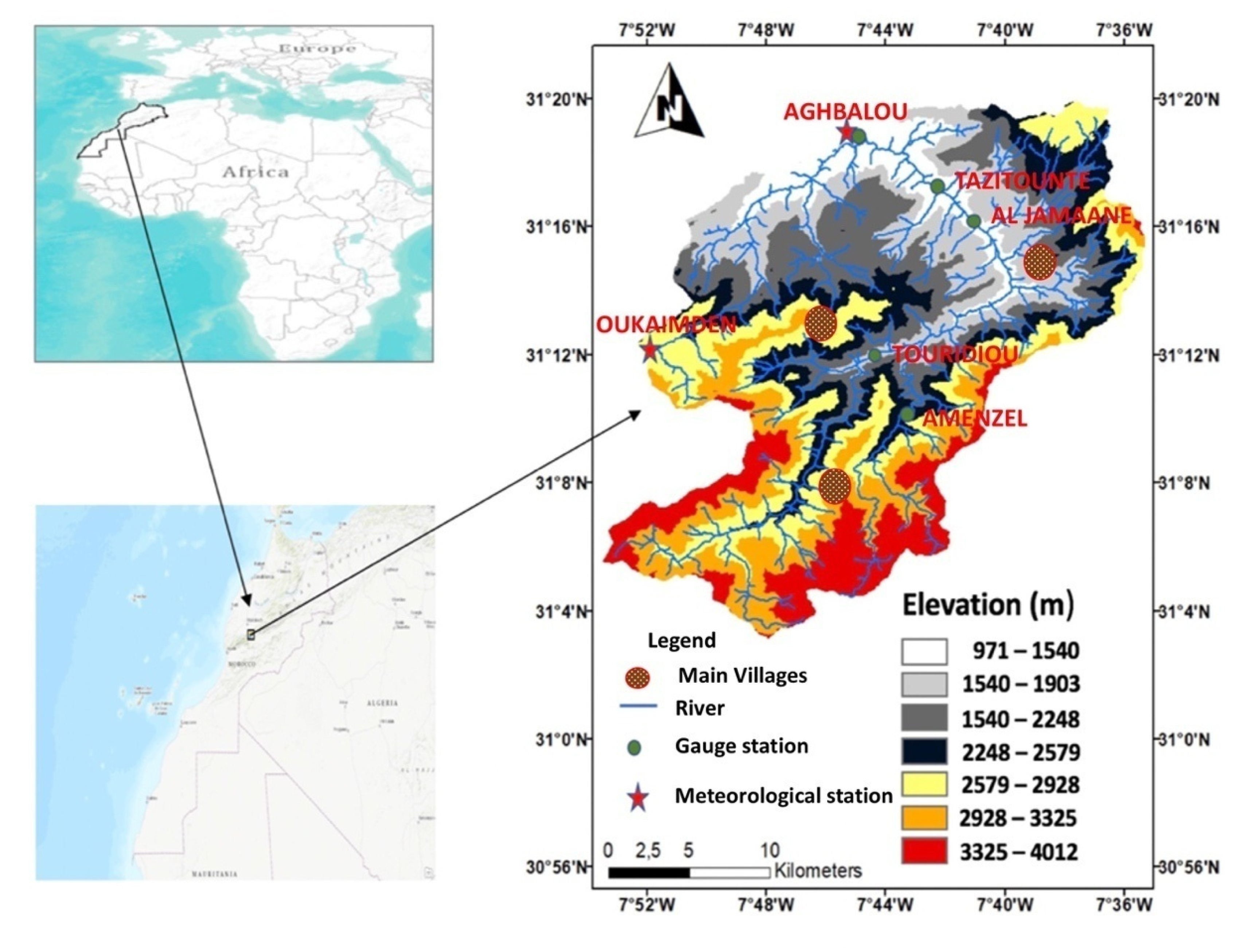
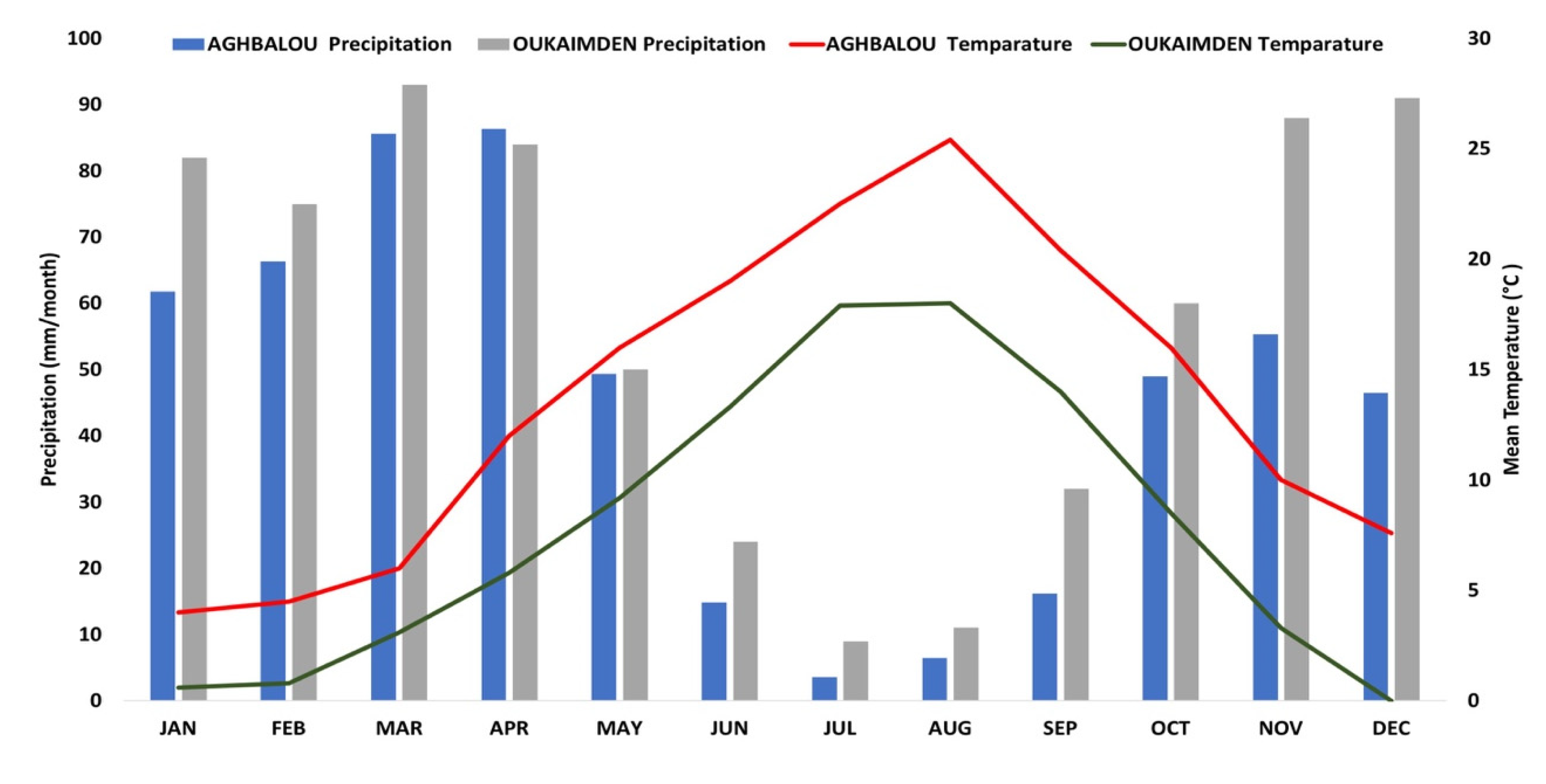
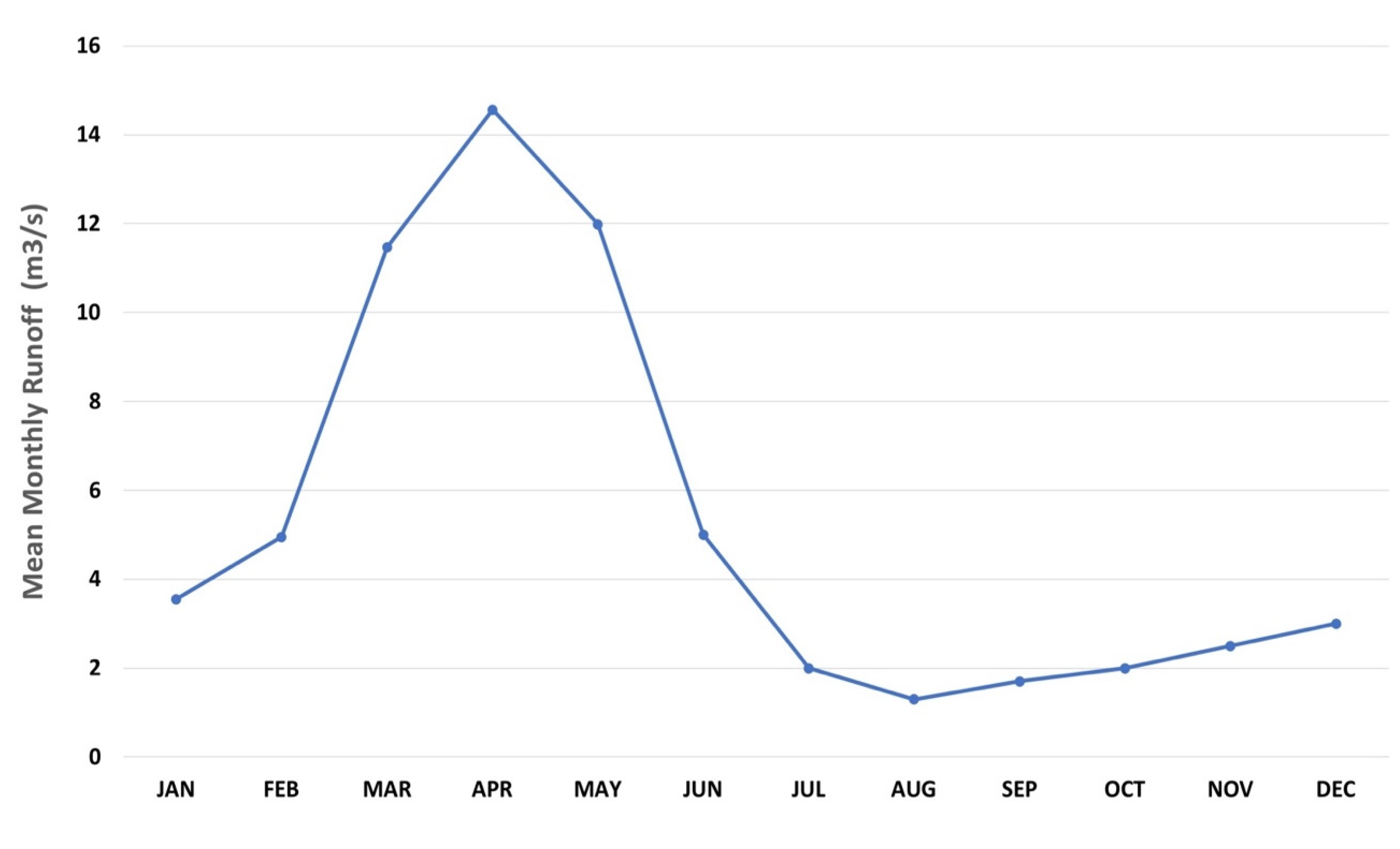
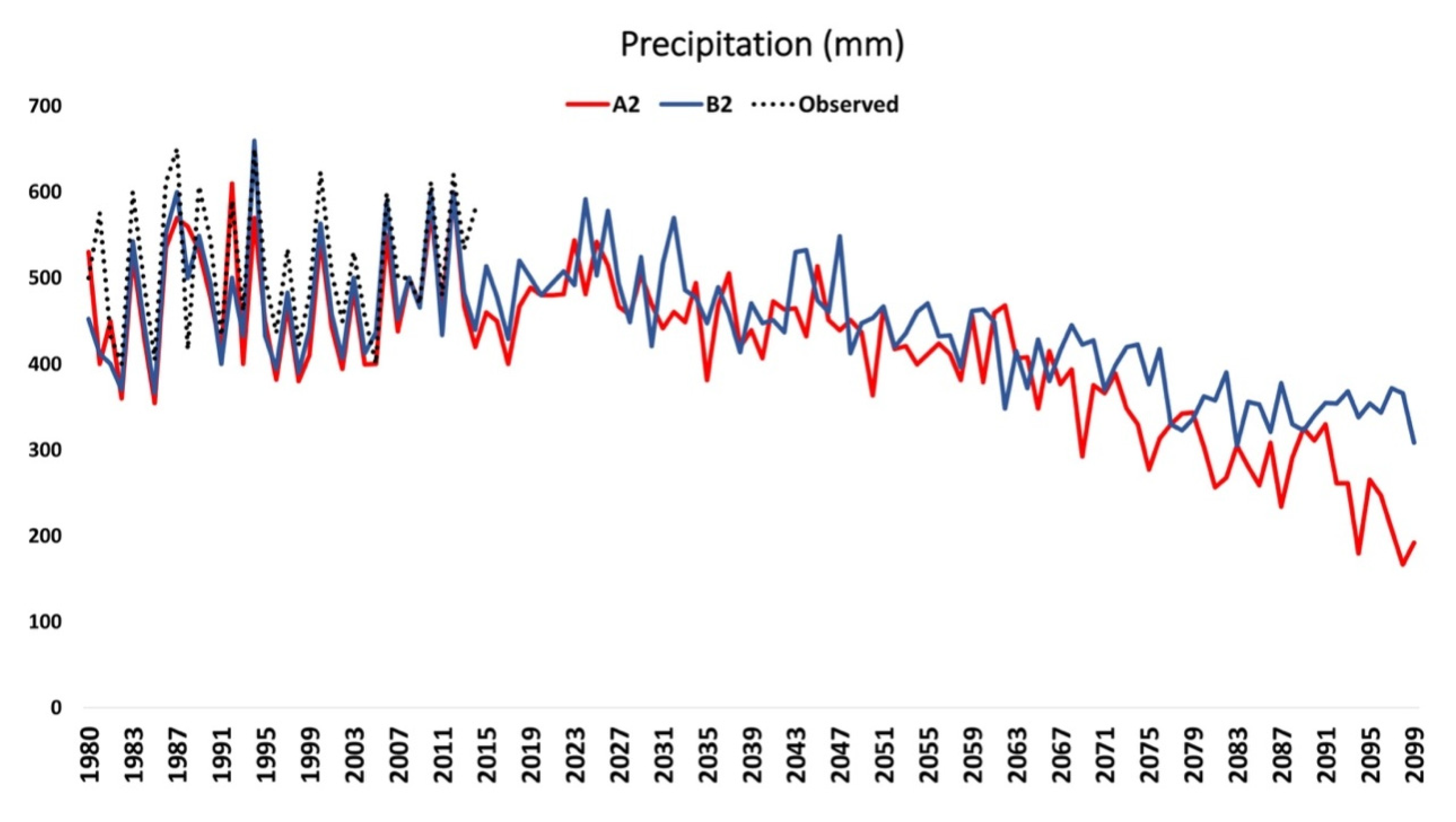
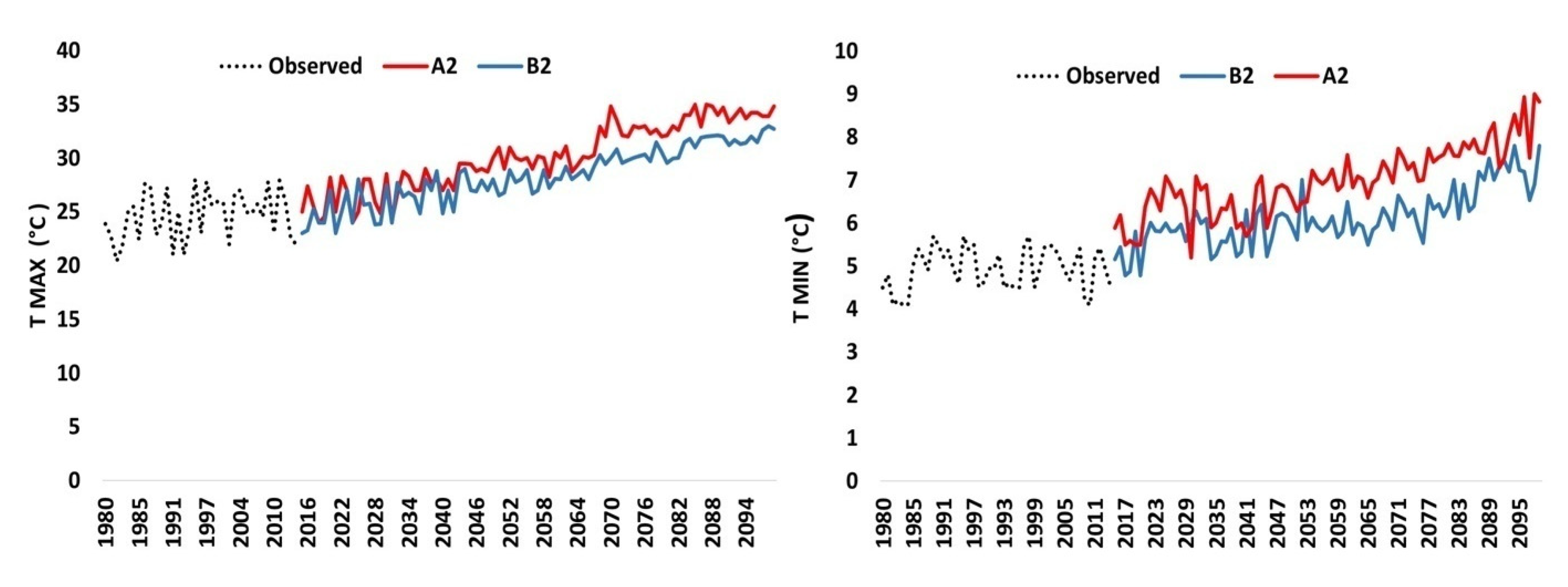
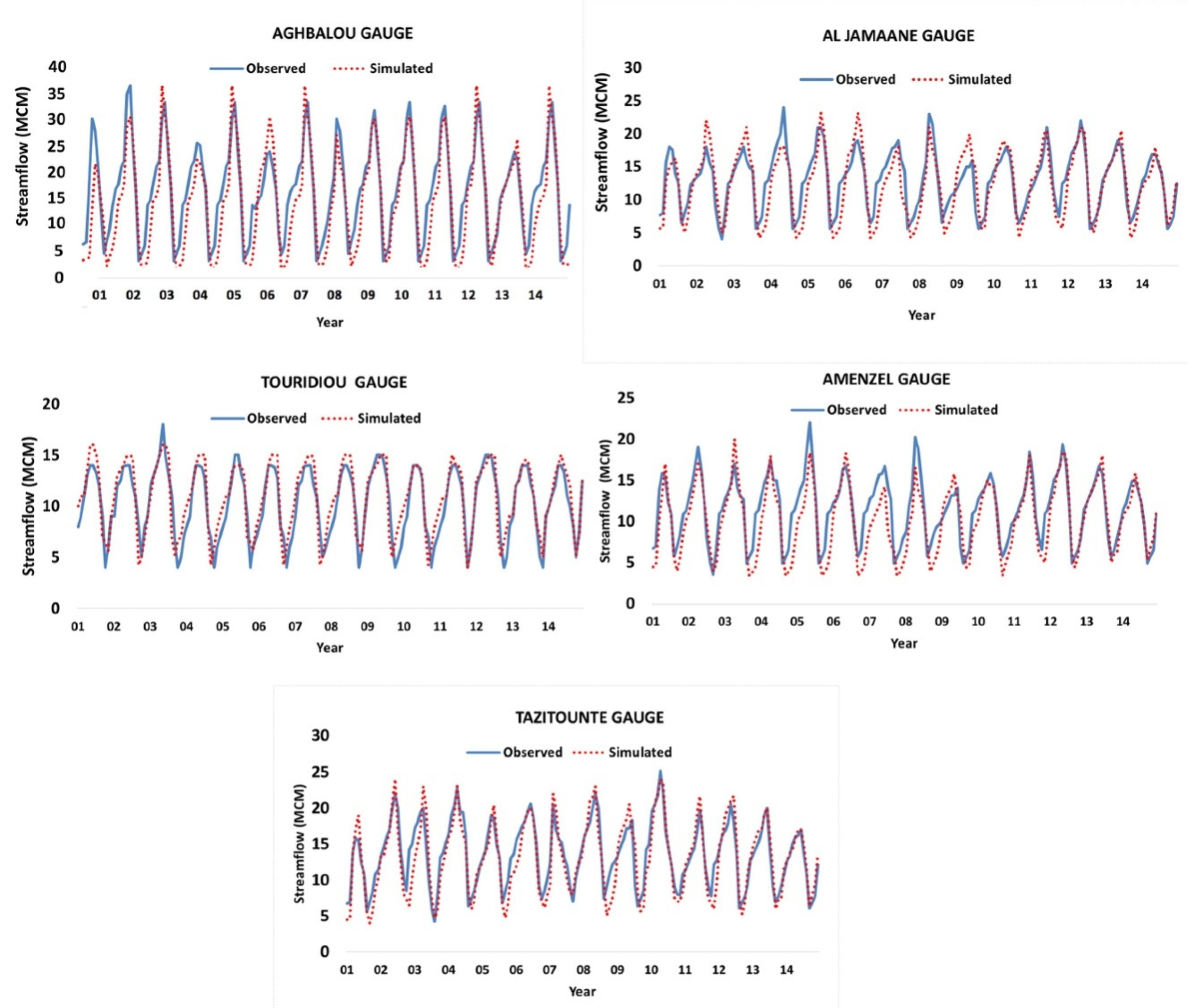
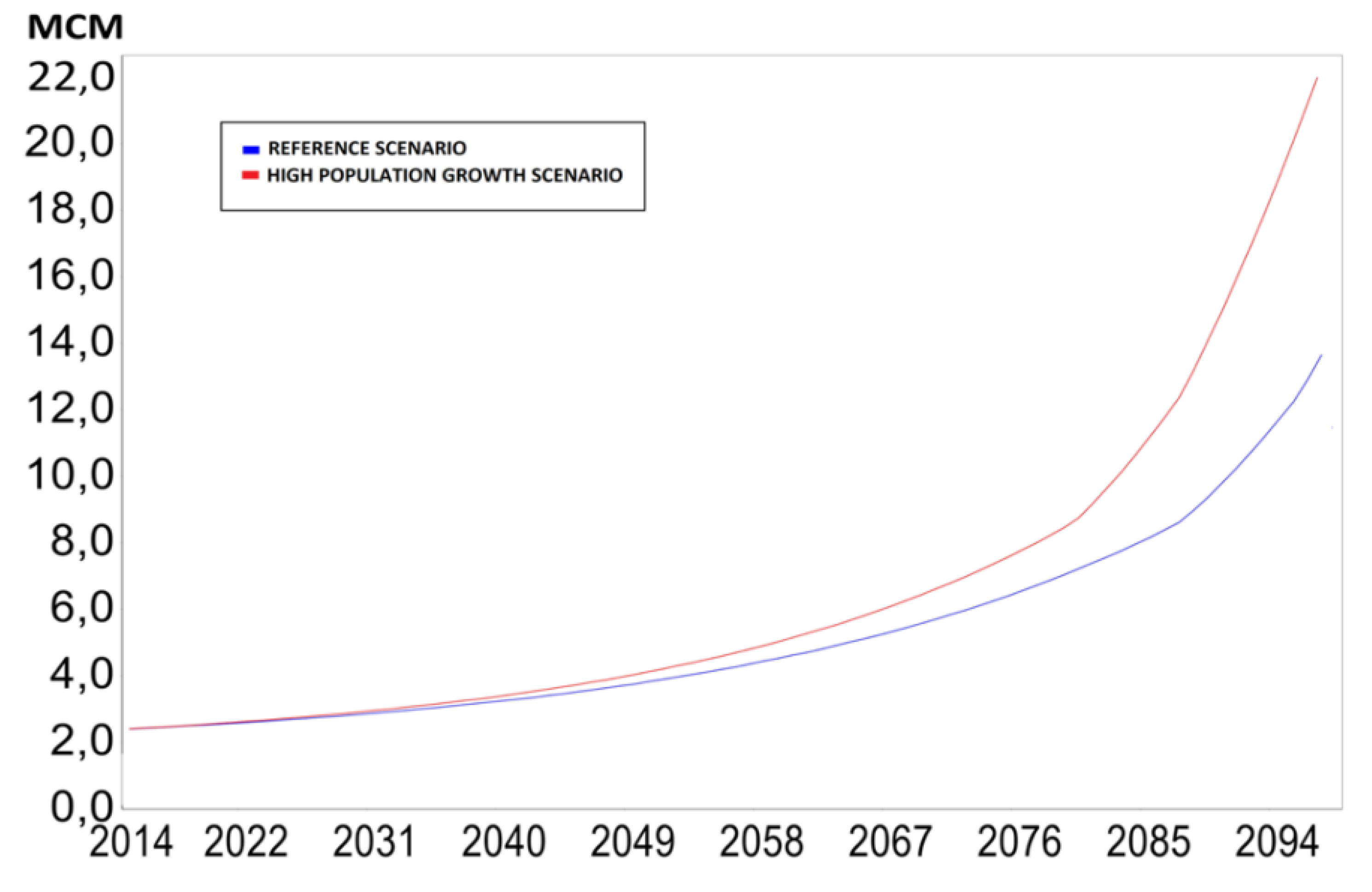
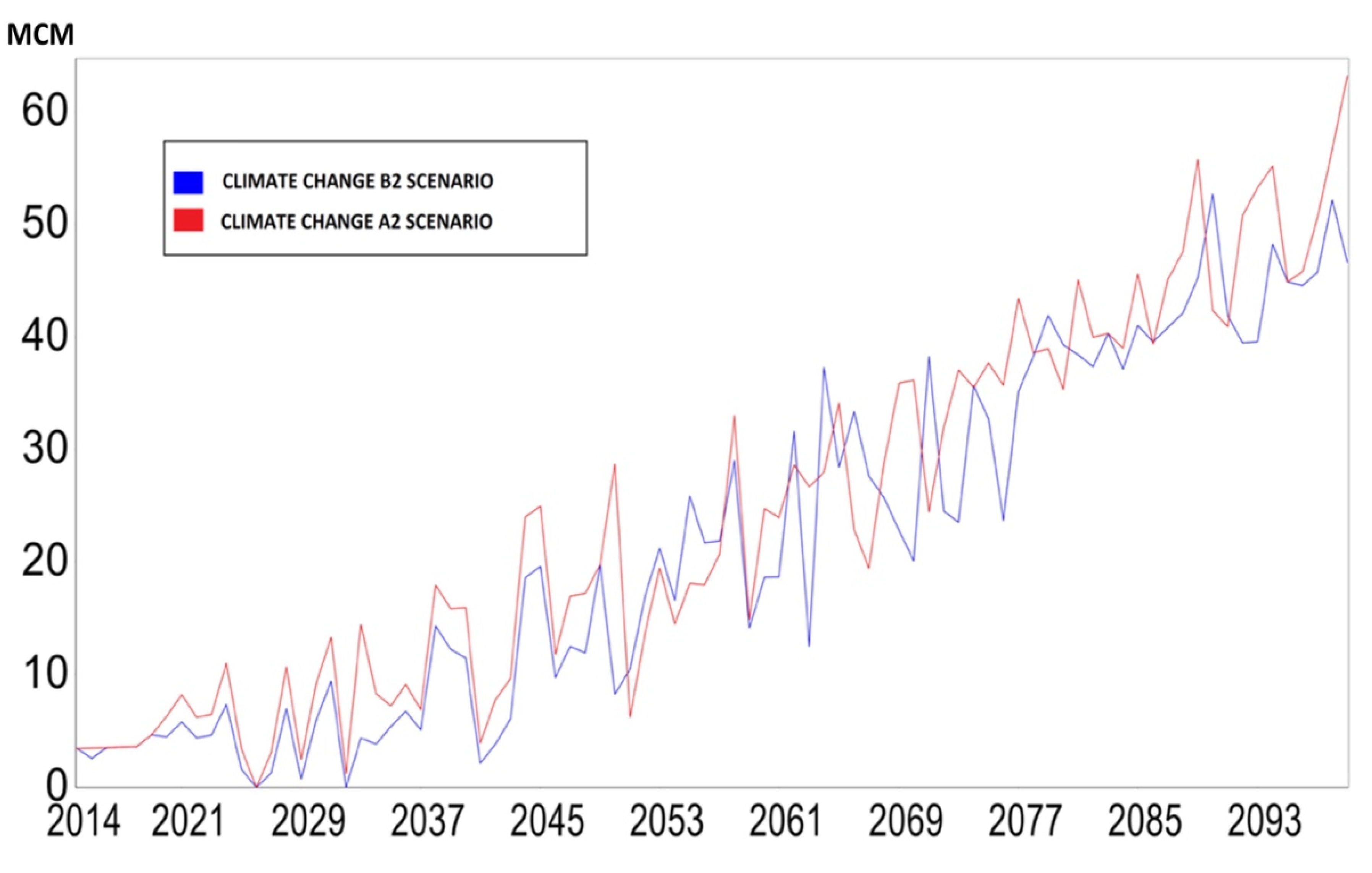
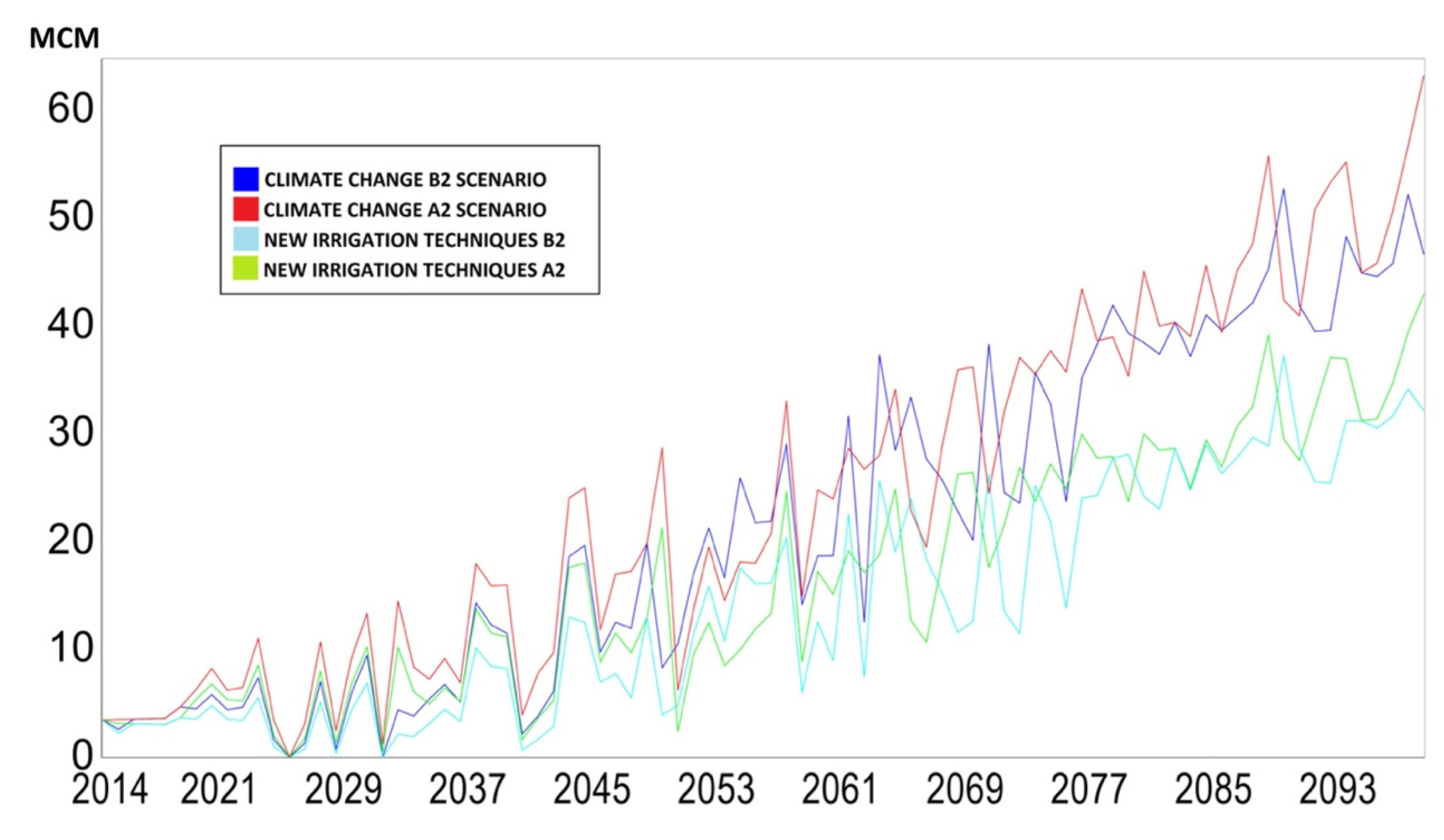
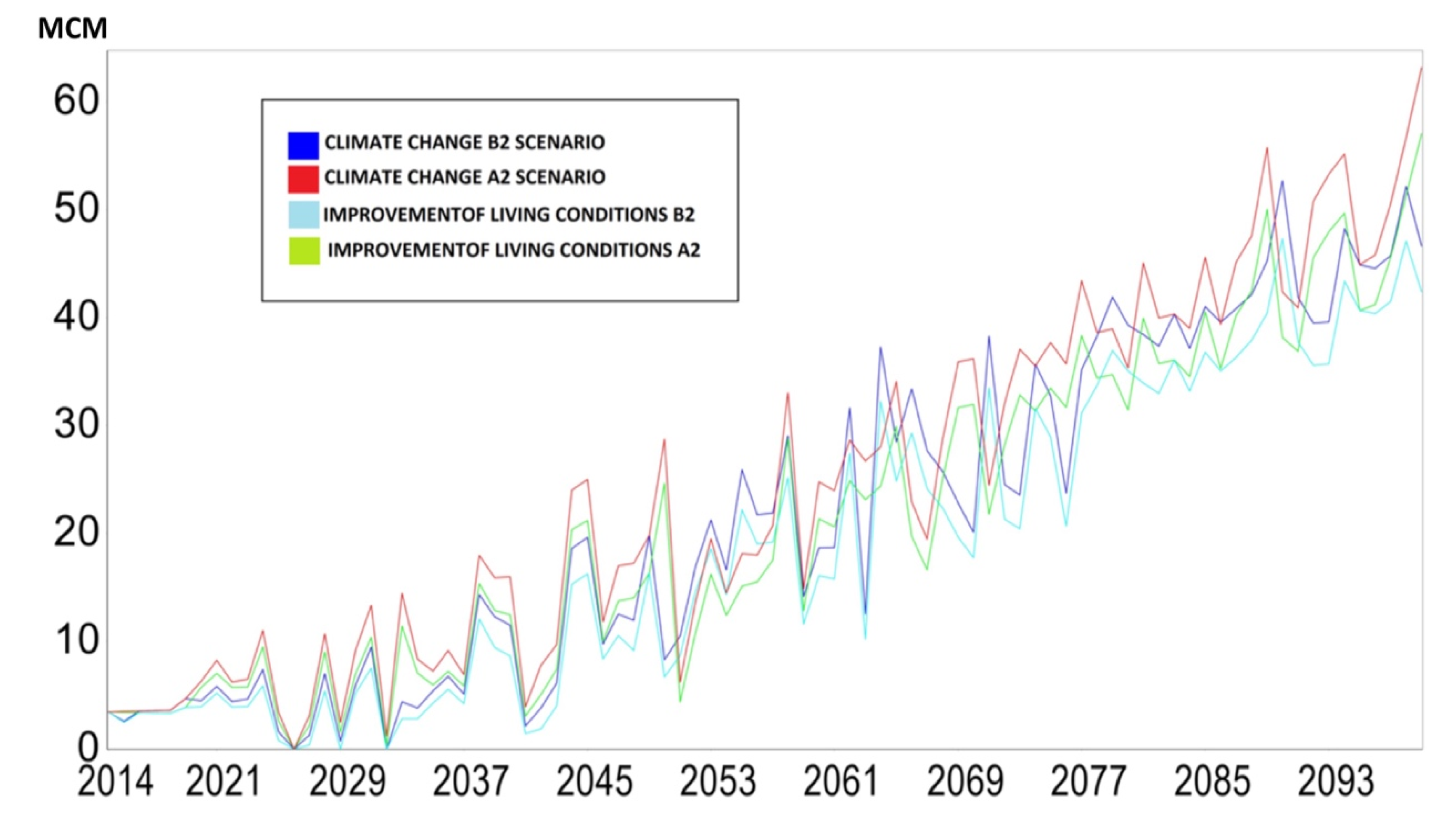
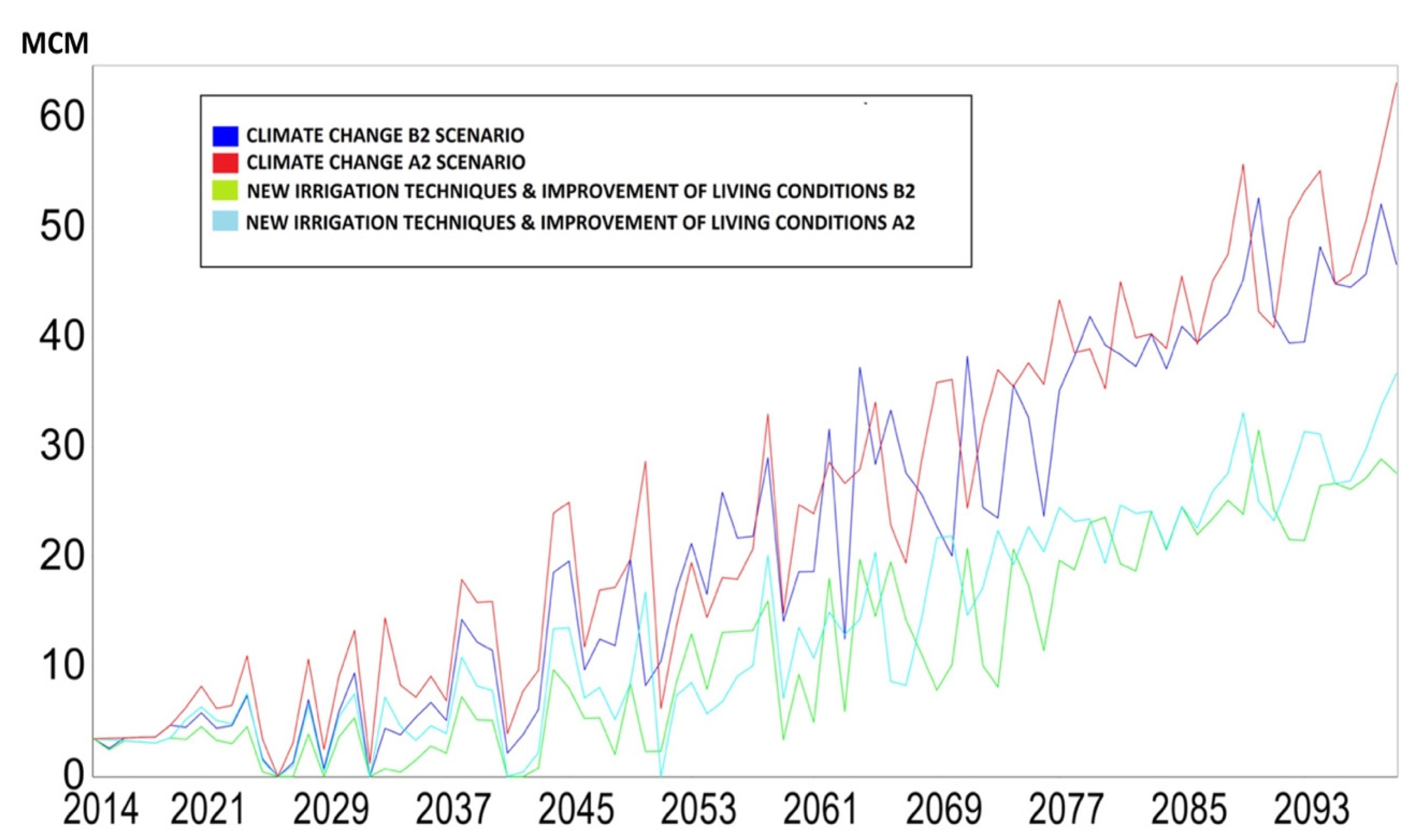
| Data | Description | Sources |
|---|---|---|
| Remote sensing data | Digital Elevation Model 30 m; MODIS land cover (2014); | USGS (https://earthexplorer.usgs.gov) |
| Large-scale climate variables | NCEP: Reanalyzed atmospheric dataset (1961–2014) HadCM3: A2 and B2 scenarios, (1961–2099) | NCEP (https://www.ncep.noaa.gov) HADCM3 (https://www.ipcc-data.org/) |
| Climate data | Precipitation; Temperature; Humidity; Evapotranspiration | Tensift Watershed Agency (Morocco); |
| Hydrological data | Gauge stations data: (2000–2014) | Tensift Watershed Agency (Morocco); |
| Demand data | Land use data Urban sector Population Water use rates Water consumption Agricultural demand Population and growth rates | Tensift Watershed Agency; (Morocco); Regional Office for Agricultural Development of Al Haaouz; (Morocco); |
| Predictand | Calibration | Validation (with Bias Correction) | ||||||
|---|---|---|---|---|---|---|---|---|
| E% | SE | R2 % | RMSE | μ | Ϭ | RE μ% | RE Ϭ% | |
| Precipitation (mm/day) | 21.0 | 0.52 | ||||||
| Statistical Downscaling Model (SDSM)-M SDSM-A | 74 58 | 9.76 23.54 | 65.00 72 | 13.41 21.63 | −4.85 −7.19 | −5.47 −3.0 | ||
| Tmax (°C/day) | 65.0 | 3.16 | R2 % | RMSE | μ | Ϭ | RE μ °C | RE Ϭ °C |
| SDSM-M SDSM-A | 88.0 90.0 | 1.21 1.80 | 18.65 23.00 | 4.07 7.31 | −0.3 −0.16 | −0.28 −1.76 | ||
| Tmin (°C/day) | 79.0 | 2.64 | ||||||
| SDSM-M SDSM-A | 96.0 97.3 | 0.96 1.33 | 5.12 8.14 | 4.33 5.12 | −0.07 −0.16 | −0.14 −0.98 | ||
| Predictand | 20s | 50s | 80s | |||
|---|---|---|---|---|---|---|
| A2 | B2 | A2 | B2 | A2 | B2 | |
| P (%) | 9.98 | 8.21 | 33.56 | 23.68 | 49.25 | 34.61 |
| Tmax (°C) | 1.6 | 1.3 | 2.7 | 2.2 | 4.2 | 3.6 |
| Tmin (°C) | 2.0 | 1.3 | 2.6 | 2.1 | 3.5 | 2.9 |
© 2020 by the authors. Licensee MDPI, Basel, Switzerland. This article is an open access article distributed under the terms and conditions of the Creative Commons Attribution (CC BY) license (http://creativecommons.org/licenses/by/4.0/).
Share and Cite
Ayt Ougougdal, H.; Yacoubi Khebiza, M.; Messouli, M.; Lachir, A. Assessment of Future Water Demand and Supply under IPCC Climate Change and Socio-Economic Scenarios, Using a Combination of Models in Ourika Watershed, High Atlas, Morocco. Water 2020, 12, 1751. https://doi.org/10.3390/w12061751
Ayt Ougougdal H, Yacoubi Khebiza M, Messouli M, Lachir A. Assessment of Future Water Demand and Supply under IPCC Climate Change and Socio-Economic Scenarios, Using a Combination of Models in Ourika Watershed, High Atlas, Morocco. Water. 2020; 12(6):1751. https://doi.org/10.3390/w12061751
Chicago/Turabian StyleAyt Ougougdal, Houssam, Mohamed Yacoubi Khebiza, Mohammed Messouli, and Asia Lachir. 2020. "Assessment of Future Water Demand and Supply under IPCC Climate Change and Socio-Economic Scenarios, Using a Combination of Models in Ourika Watershed, High Atlas, Morocco" Water 12, no. 6: 1751. https://doi.org/10.3390/w12061751
APA StyleAyt Ougougdal, H., Yacoubi Khebiza, M., Messouli, M., & Lachir, A. (2020). Assessment of Future Water Demand and Supply under IPCC Climate Change and Socio-Economic Scenarios, Using a Combination of Models in Ourika Watershed, High Atlas, Morocco. Water, 12(6), 1751. https://doi.org/10.3390/w12061751





